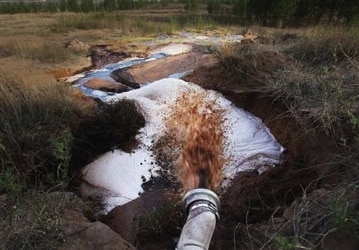According to a new report, the coal industry’s pollution is contaminating our water supplies, our regulatory agencies, and even our political process. The report, a joint project by the Waterkeeper Alliance, Clean Water Action, the Sierra Club, Earthjustice, and the Environmental Integrity Project, shows that when it comes to spewing toxic chemicals into our waterways, the coal industry is public enemy number one.
The report found that many coal plants across the country are releasing coal ash waste and scrubber waste without any federal oversight, and many are held to standards that are outdated and virtually limitless. Many of the standards currently in place were written more than 30 years ago, and they do not include any regulations on toxic threats that had not yet been identified at the time the original rules were put in place.
A few highlights of the report, from the Sierra Club:
Of the 274 coal plants that discharge coal ash and scrubber wastewater into waterways, nearly 70 percent (188) have no limits on the toxics most commonly found in these discharges (arsenic, boron, cadmium, lead, mercury, and selenium) that are dumped directly into rivers, lakes, streams and bays.
Of these 274 coal plants, more than one-third (102) have no requirements to monitor or report discharges of these toxic metals to government agencies or the public.
A total of 71 coal plants surveyed discharge toxic water pollution into rivers, lakes, streams and bays that have already been declared impaired due to poor water quality. Of these plants that are dumping toxic metals into impaired waterways, more than three out of four coal plants (59) have no permit that limits the amount of toxic metals it can dump.
Nearly half of the coal plants surveyed (187) are operating with an expired Clean Water Act permit. 53 of these power plants are operating with permits that expired five or more years ago.
Specific dangers arise with each of the toxic chemicals listed above. The most troubling are arsenic and lead, two heavy metals that are toxic to both humans and animals. Neither of these metals deteriorates over time, and once they enter the body, they are not expelled.
Mercury has been linked to impaired fetal development and diminished cognitive functioning and development, presenting a particularly dire situation for women who are pregnant or nursing.
Since we know the dangers associated with these toxic coal waste components, it is only fitting to question why our federal regulatory agencies would allow the coal industry to continue to dump this waste into our waterways. The answer is provided in the report: Industry influence.
The White House Office of Management and Budget (OMB) was prepared to crack down on the dumping of toxic coal waste, but once the final rules were written, the OMB caved to industry pressure and pulled back on standards that would have protected human health and the environment.
Abigail Dillen, Earthjustice’s Climate & Energy Vice President, says that the industry was allowed to meet behind closed doors with federal regulators to help draft new, weaker standards for the industry. This appears to be par for the course for the Obama administration, which has allowed the coal industry to have personal audience with high-ranking government officials on countless issues.
The solution to the problem is to strengthen the Clean Water Act to outlaw the dangerous behavior of the coal industry. If they are allowed to continue dumping toxic waste into the environment, the cumulative effect is going to become worse and worse for future generations.
The only problem is that we need an administration willing to stand up to the interests of the coal lobby in favor of the interests of the American public. President Obama has yet to rise to the challenge.
Subscribe to our newsletter
Stay up to date with DeSmog news and alerts







